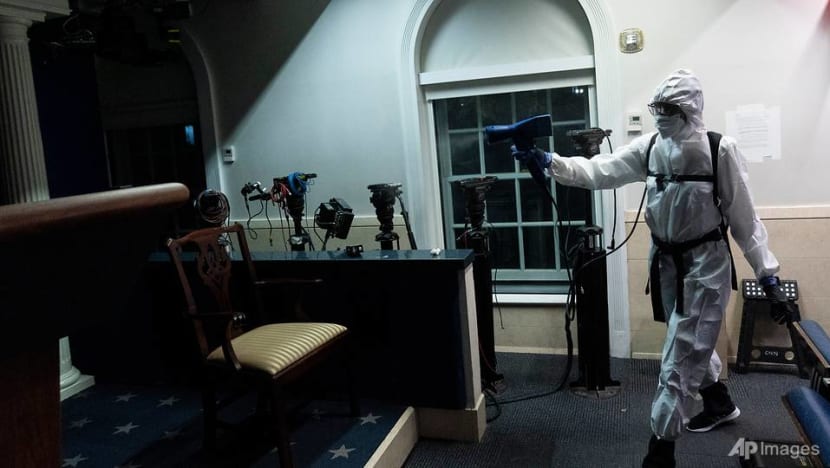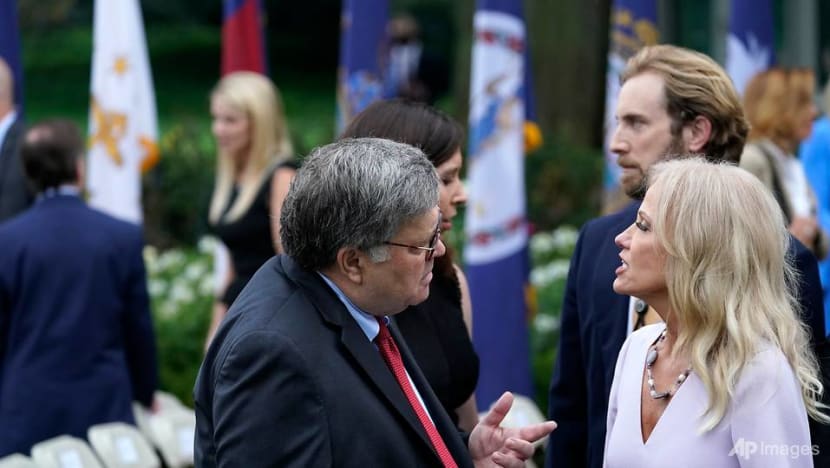White House COVID-19 testing not enough to protect Trump

A member of the cleaning staff sprays the James Brady Briefing Room of the White House, Oct 5, 2020, in Washington. (Photo: AP/Alex Brandon)
WASHINGTON: His press secretary once described President Donald Trump as the "most tested man in America" when it came to COVID-19.
And variations on that message were the White House's ready response any time critics questioned the president's lax approach to following guidelines for avoiding the coronavirus.
But that testing operation proved woefully insufficient in protecting the president and those who work for him at the White House, as evidenced by a string of positive tests over the past week for Trump, his wife and others in their orbit.
READ: US President Trump returns to a White House hard hit by COVID-19 after leaving hospital
Trump demonstrated in dramatic fashion that relying on testing alone is not enough to create a safe bubble. Mask wearing and social distancing are other key ingredients for preventing the spread of COVID-19, and both have often been in short supply at the White House.
From the earliest days of the virus, Trump has provided conflicting advice on wearing a mask, noting that federal health experts were recommending them, but adding that "I don't think I’m going to be doing it".
At another point, he said that "maybe they're great, and maybe they're just good. Maybe they're not so good".
And just last week, he poked at Democratic presidential rival Joe Biden on the topic: "Every time you see him, he's got a mask. He could be speaking 200ft (away) from them, and he shows up with the biggest mask I've ever seen."
READ: In first, Trump dons mask in visit to a military medical facility

While the White House has not insisted on masks, it has insisted on testing. Anyone in close proximity to the president or vice president is tested prior to the day's events, including reporters. The White House says the president is also tested regularly, as are his most senior aides.
"He's tested more than anyone, multiple times a day. And we believe that he's acting appropriately," White House press secretary Kayleigh McEnany said in July when asked whether the president was sending mixed messages on mask wearing. McEnany herself tested positive for the virus on Monday, she said.
Trump's doctor, navy commander Sean Conley, has refused to say when Trump last tested negative for COVID-19.
READ: Doctors monitoring Trump's lungs, giving steroid to fight COVID-19
A negative test result can sound reassuring, but it does not necessarily mean a person is free from the coronavirus and not contagious.
When the virus enters the body, it takes over a cell's machinery to copy itself, while fending off the body's immune defences. But the process takes a few days, so it can take a while before viral particles can be detected by a test. In other words, testing too early can mean no virus will be collected on the swab.
There are other reasons for false negative test results. A test could be conducted poorly and not get a good sample. And compared with other tests, rapid tests return more false negatives.
The Food and Drug Administration has said the Abbott ID Now test – one used for screening at the White House – is meant to be used with people who are suspected of being sick, and a negative test result does not rule out COVID-19.

"It's helpful to keep in mind that tests discover the presence of coronavirus once there's enough viral material in a person to be able to detect it," Abbott spokesman John Koval said in an email. "No test detects the virus immediately after the person becomes infected."
"Testing alone doesn't prevent disease spread," said Dr Cyrus Shahpar, a former Centers for Disease Control and Prevention scientist now at the non-profit group Resolve to Save Lives, which works to prevent epidemics. It must be combined with consistent mask wearing, hand washing, staying 6ft apart and avoiding large gatherings.
READ: Face masks in the time of COVID-19 – Six questions answered
The main benefit of testing, Shahpar said, is to identify people with infections and isolate them before they can spread the disease to others.
"Tests can have false positives and false negatives, and no test is perfect. It is also just a snapshot of the situation when the person was tested," Shahpar said.
Asked if the testing provided a false sense of security, spokesman Judd Deere said the physician to the president and the White House Military Office worked with the White House to "ensure all plans and procedures, including testing, incorporate current CDC guidance and best practices for limiting COVID-19 exposure to the greatest extent possible".
READ: Trump White House, campaign staff who have tested positive for COVID-19

Health experts also advise social distancing, but that recommendation has been ignored for several recent White House events, most notably Trump's nomination acceptance speech on the South Lawn in late August and a Sep 26 Rose Garden ceremony announcing the nomination of Judge Amy Coney Barrett to serve on the Supreme Court.
While the events were held outdoors, attendees sat shoulder-to-shoulder with barely a mask in sight.
Trump gathered more than 150 people in the Rose Garden, where they mingled, hugged and shook hands – overwhelmingly without masks. There were also several indoor receptions, where Barrett, her family, senators and others gathered in the close quarters inside the White House.
Among those who attended who have now tested positive, in addition to Trump, his wife Melania and McEnany: Former New Jersey governor Chris Christie, former White House counsellor Kellyanne Conway, the president of the University of Notre Dame and at least two Republican lawmakers – Utah Senator Mike Lee and North Carolina Senator Thom Tillis.
There is no way to know if the Rose Garden event was where Trump was exposed. The president had a full week of official and campaign events before his hospitalisation on Friday.
BOOKMARK THIS: Our comprehensive coverage of the coronavirus outbreak and its developments
Download our app or subscribe to our Telegram channel for the latest updates on the coronavirus outbreak: https://cna.asia/telegram












